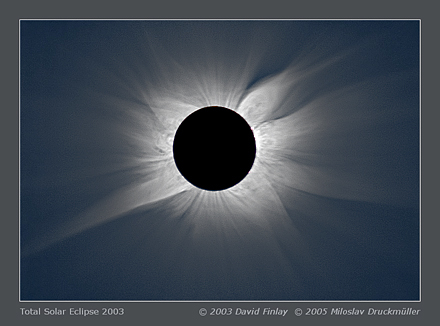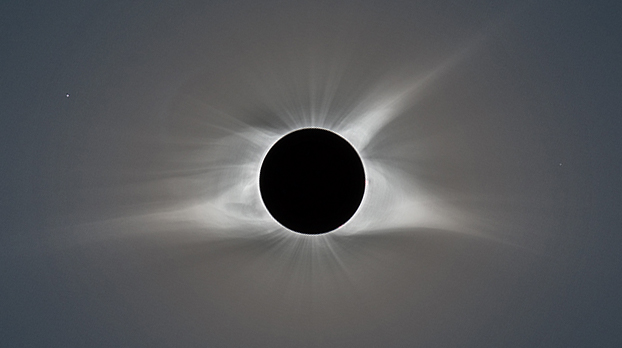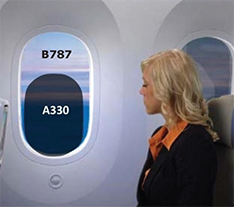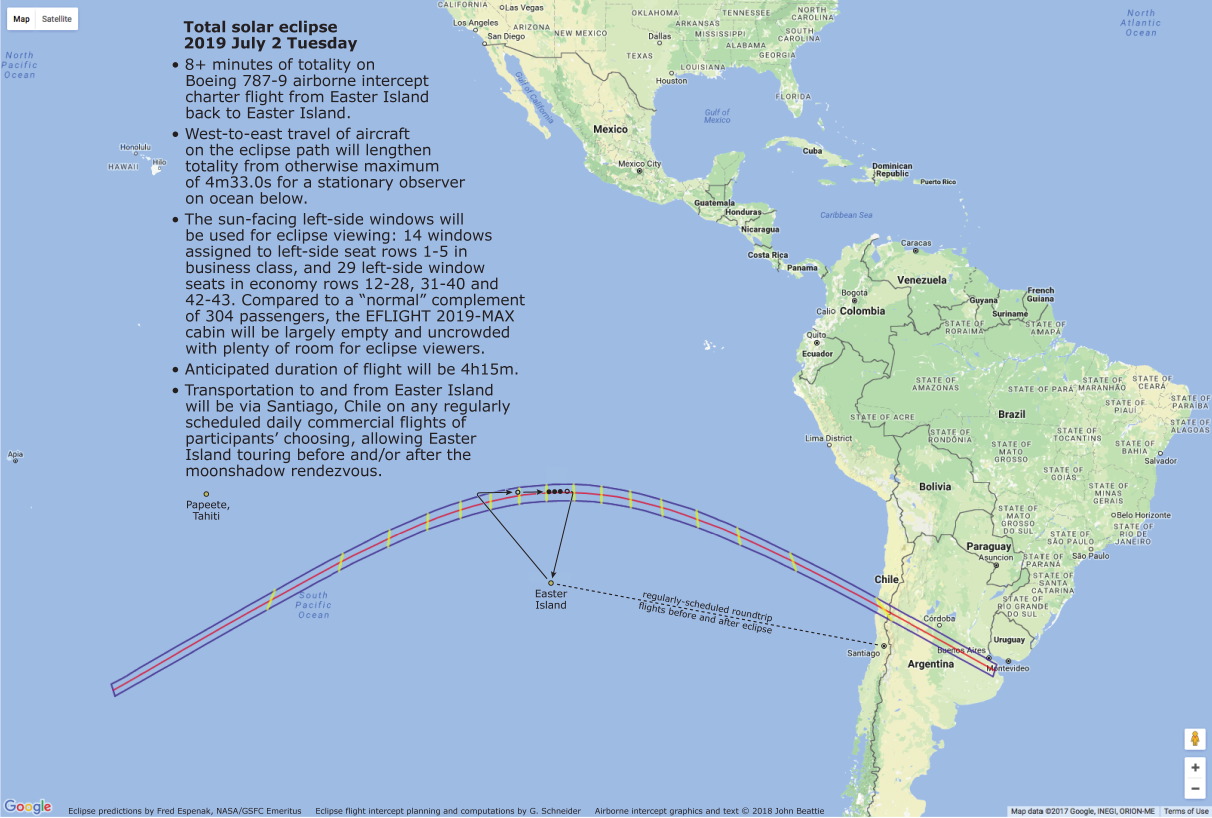 Path of Totality
Path of Totality
A Rare Chance to "Fool Mother
Nature"
The specifically
favorable
geometrical and astrodynamic circumstances of TSE 2019 at the point of
greatest eclipse will
enable a spectacular
opportunity to "chase", and slow the passage of, the Moon's umbral
shadow. By doing so, at the right time and place with a suitable high-altitude commercial jet aircraft, totality will be prolonged to between ~ 8-1/4 and 9+
minutes. Very conservatively with no wind, from an aircraft
flying at 488 knots (the nominal cruise speed of a Boeing 787-9 at
37,000 ft.), totality will be stretched by the speed of the aircraft
partially keeping pace with the traverse of the Moon's shadow to an
astounding minimum of 8m 14s; compare to on the ground at oft-cloudy La
Serena with 2m 12s. Statistically prevalent July tailwinds aloft (typically ~ 55 knots from 270°) in the Pacific Ocean region where greatest eclipse occurs,
however,
would yield over 9 minutes
of totality! This is significantly longer than
nature and celestial mechanics (without aircraft 'augmentation') can
ever
allow; that being ~ 7-1/2 minutes, next closely approached by the TSEs
of 2168
and 2186 AD (quite a while to otherwise wait).
"Slow
and Steady, Wins the Race!"
Our "EFLIGHT 2019-MAX" will intercept the lunar umbra traversing the
surface
of the Earth where its velocity is at a minimum -- at just over 2,000
km/hr and where, as a result, the duration of totality is naturally
longest (4m 32s) anywhere along the path of totality for a stationary
observer. See the graph below and compare, for example, to the
umbra's speed as it crosses the Chilean west coast at ~ 10,000 km/hr
where (due also to other geometrical factors) the centerline duration
of totality has declined to 2m 33s.
Umbral Velocity (km/hr) vs. UTC (HH:MM:SS)
At our mid-eclipse intercept point, at the point of greatest and
maximum duration totality, our aircraft will be traveling almost
identically in the direction of the Moon's shadow (see chart later on
this page), with a true air speed (TAS) of ~ 904 km/hour. So,
even
without a likely tailwind, the relative speed of the Moon's shadow to
the aircraft will be cut almost in half (by ~ 45%) leading to a
duration of totality of ~ 8-1/4 minutes (or longer with the assist of a
probable tailwind).
With the singular exception of a
July 11, 2010
solar eclipse flight, that we then orchestrated with similar
geometrically favorable circumstances then yielding 9m 23s of
totality, this will be only the
second extreme-duration totality flight ever undertaken by a
non-military or non-experimental aircraft. With the "similar"
opportunity
presented by TSE 2019, we are extremely pleased to announce that, in
cooperation with LATAM Airlines providing a Boeing 787-9 aircraft for
an exclusive eclipse-viewing optimized charter dubbed EFLIGHT 2019-MAX, we are now
prepared
to 'do it again' with the next generation of like-minded, and
high-flying, umbraphiles!
EFLIGHT
2019-MAX
For
Those Who Can Never
Get Enough Totality and Who
Wish to Obviate Concerns of Ground-Level Weather...
With EFLIGHT 2019-MAX we will be conducting an ~ 4.5
hour end-to-end duration eclipse-viewing flight departing from Mataveri
International Airport on Easter Island, Chile. The eclipse flight
will launch mid-morning on 2 July 2019 (see details below) to centrally
rendezvous with the base of the lunar umbral shadow at the point of
greatest (maximum) eclipse. Our Mid-Eclipse Intercept (MEI) point is
advantageously appx. 1,100 km (600 nautical miles) nearly due north of
Easter
Island. There, the velocity of the Moon's shadow is at a minimum
along the path of totality, enabling an optimal view of not only
totality from the north-facing sun-side (left) passenger windows of our
aircraft, but also an extraordinary and unparalleled view of the
approach
and recession of the lunar umbral shadow slicing through the sky above,
and projected on the Ocean below to a far-horizon distance of ~ 370
km.
For this EFLIGHT 2019-MAX eclipse-viewing opportunity, we have arranged
to charter a Boeing 787-9 "Dreamliner" aircraft from LATAM
Airlines,
with a baseline flight-plan optimized for an MEI rendezvous with the
center of the umbral shadow at maximum eclipse 19:22:58 UTC. The
aircraft will follow a pre-planned, eclipse-viewing optimized,
trajectory (the "totality run"), compensating for any variations of
winds aloft. At nominally 37,000 ft above sea level, the concerns of
weather (and clouds) will remain below - though we may go even higher
if
conditions and margins permit. The high-contrast view of the corona
against the umbra-darkened background sky at these altitudes, above ~
80% of the Earth's atmosphere, is unparalleled, spectacular, and
breathtakingly glorious.
There are, of course, many
OTHER reasons to take to the skies to observe a TSE from such a lofty
venue, including:
TOP 10 REASONS FOR A HIGH-ALTITUDE
TSE 2019 ECLIPSE FLIGHT
DEPLOYMENT/RELOCATION FLEXIBILITY
To Find
the BEST Spot in the
Area of Operations for Observing
|
CLOUD OBSCURATION AVOIDANCE
@ 37,000 ft + is Virtually Assured
|
TOTALITY PROLONGATION FOR MAXIMUM ECLIPSE
Aircraft
Speed Extends the
Duration of Totality
|
SKY TRANSPARENCY
Significantly
Improved -- Very Low
Particulate/Aerosol Scattering
|
SKY DARKNESS
Much
Higher Contrast Coronal
Visibility and to Larger Circumsolar Distance
|
IMPROVED ASTRONOMICAL SEEING
"R_naught"
Decreases with
Increasing Altitude
|
REDUCED ATMOSPHERIC TURBIDITY
Vorticity
& Sheer Decline
in Power Above Lower Troposphere
|
PANCHROMATIC
VISIBILITY
IR and
UV "Windows" Open Up or
are Extended
|
UNPARALLELED HORIZON REACH &
OBSERVATION VISTA
Apparent
horizon 377 km
distant, depressed 3.4° (at 37,000 ft)
|
AMAZING VIEWS OF THE UMBRA APPROACH &
RECESSION
Simultaneously, in
the dark sky above, and on the clouds & ocean surface far
below
|
And,
What a View it Is!
Although with the obvious
disclaimer that no photograph can even most distantly approach
capturing the beauty of totality discerned by the eye from an aircraft
(or elsewhere!) here
are just a few from prior EFLIGHTs that do also answer the question
"can I get 'good' photos through an airplane window?" (Image
stabilized or vibration reduction lenses do help in that, but even
without, some results are dramatically amazing.)
TSE 2003 Coronal Detail
EFLIGHT 2003 over Antarctica in a Boeing 747-400

Thanks to David Finlay and Miloslav Druckmuller
TSE 2008 Inner (left) and Outer (right) Corona
EFLIGHT 2008 @ 83° N Latitude in an Airbus A330-200
Left: Bill Kramer and Glenn Schneider. Right:
Glenn Schneider
TSE 2015 - Umbral Interface at the Moment of Second
Contact
EFLIGHT 2015 over the Norwegian Sea in a Boeing 737-800

OUR Baseline "Totality Run": The Moon's Shadow Chasing Us!
Our chosen MEI point and its time-correlated UTC allows us to define an
aircraft trajectory through, and flanking, totality that puts the Sun
"straight out" the passenger windows, while simultaneously providing
the longest possible totality for a given ground-speed. For our
baseline totality run centered on our MEI point, the Sun at
mid-totality will be almost due north (azimuth 359°), and thus
the aircraft flying nearly due east (bearing 89°). For a
conservative "no wind" condition, the Moon's shadow ('chasing' us) will
overtake the aircraft at contact 2 (traveling at 2,018.7 km/hr relative
to the surface of the Earth at that instant) with the precisely
orchestrated timing as
schematically represented in the graphic below.
How
Long is Totality as Seen From the Aircraft?
Our baseline Totality Run for EFLIGHT 2019-MAX is predicated and
computed very conservatively with no winds aloft with then ~ 8-1/4
minutes of totality. However, if much more
statistically-likely favorable west-to-east tailwinds of ~ 55 knots
prevail on eclipse day the duration of totality would increase to just
over 9 minutes, and longer for stronger tailwinds aloft. Our
robust intercept plan holds the MEI constant while allowing the ground
speed with in situ tailwinds to increase, which will result
in a longer duration of totality, though at different UTCs for contacts
2 and 3 than the "no wind" baseline.
CO-MOVING LOCAL CIRCUMSTANCES FOR
BASELINE MEI (provisional)
============================================================
MEI: 19:22:58 UTC, FL 370, TAS =
488 kts (Mach 0.84), HDG = 89.0° (no wind)
Lunar
Limb Profile Corrected Duration of Totality: 8m 14.2s
UTC
(hhmmss)
LATITUDE
LONGITUDE ALT(d)
AZI(d) PA(d)
C2 19h 18m
47.0s 17° 18' 42.6" S 109° 35' 01.7" W
+49.7 1.3 87.1
MID 19h 22m 58.0s
17° 18' 09.7" S 109° 00' 05.9" W
+49.7 359.5 ----
C3 19h 27m
01.2s 17° 17' 30.5" S 108° 25' 01.8" W
+49.6 357.7 268.6
In situ predictions of winds aloft on eclipse morning (and updated on
our outbound cruise from Easter Island toward our totality run) will
allow us to re-optimize the final totality run responsively, as
we have with our prior eclipse viewing flights; Dr. Glenn Schneider has
orchestrated thirteen eclipse viewing flights since 1986. Like
those prior, EFLIGHT 2019-MAX planning and implementation will be
benefited through the use of his well-proven EFLIGHT
software for a dynamic and robust eclipse flight plan and execution.
Our LATAM Boeing 787-9
"Dreamliner" Aircraft and Operations
For
EFLIGHT 2019-MAX we have arranged to charter, for our exclusive use, a Boeing 787-9
"Dreamliner" aircraft from LATAM Airlines.
LATAM, in addition to acting as
an aircraft provider, will conduct and operate EFLIGHT 2019-MAX to our
exacting specifications to assure optimal eclipse viewing. To
reduce the end-to-end flight time (and hence cost) of the charter we
have arranged to launch EFLIGHT 2019-MAX from Mataveri
International Airport on Easter Island, Chile. This is the
nearest launch point to our MEI for a range-capable commercial aircraft
suitable for the requirements of the flight.
Our prior-designated EFLIGHT 2019-MAX aircraft
will be delivered for our use on Easter Island with more than
sufficient lead time for our in situ pre-boarding preparations from an
arranged, re-timed as an early morning, scheduled flight out of
Santiago, Chile. This earlier-than-normal feeder flight is not
part of our charter arrangements, but we do expect many (if not all)
EFLIGHT 2019-MAX charter flight participants to avail themselves of the
logistical convenience of using that schedule-coordinated flight for
transport to Easter Island. (Participants may, of course, avail
themselves of a visit to Easter Island prior to, or we suggest after,
eclipse day, as may be arranged and co-ordinated with the holder of our
charter contract, T.E.I.
Tours and
Travel.)
Why
a Boeing 787-9?
50°
Solar Elevation at MEI -- No problem with the B787-9
"Dreamliner"
Aircraft
It may seem counter-intuitive to
use a wide-body (nine seat across in economy class) aircraft for an
eclipse observation flight where only the windows on the sun-side of
the aircraft can be used to view totality. The simple fact is
that no other range-capable high-altitude commercial jet aircraft
available for charter provides the "look-up" angle through its
passenger windows needed for
comfortable eclipse viewing for the EFLIGHT 2019-MAX MEI that the
B787 aircraft uniquely does. It is a serendipitously
fortuitous circumstance that LATAM routinely operates B787-9
aircraft in and out of Easter Island with both availability and
capability for our customized charter.
To achieve an extraordinary maximum duration of > ~ 8-1/4
minutes of
totality by air, this total eclipse must be observed where the altitude
of the Sun will be approximately 50° above the
astronomical horizon, i.e. at the point of Greatest Eclipse. Viewing
the eclipse at this relatively high
solar altitude, a bit more than "half
way
up" the sky, out the aircraft windows would be problematic for eclipse
viewing with many (most) commercial jet-liners. But, uniquely not
so for the Boeing 787-9 Dreamliner that has exceptionally "tall" (47
x 28 cm) windows that are canted inward toward the cabin interior at
the
top with a slope angle of 16°. Combined, these unique window
characteristics will provide exquisite views of the eclipse at a
50°
solar elevation and of the shadow traversing on the Ocean or cloud-tops
below. John
Beattie comments, very positively, on his first-hand experience and
research for viewing out the B787-9 windows.
Some may know that the B787's windows are
shadeless. The B787 windows contain an electro-chromic (EC) layer
that is dimmable by those not wanting to see the outside world
(definitely not eclipse chasers!) by applying a voltage to the EC
layer. Fortunately, the EC layer is fully transparent (and
colorless) when no voltage is actively applied. So, "turning them off"
makes them transparent, not the other way around. So, they "fail
safe" as far as eclipse chasers might otherwise worry. No
voltage, no opacity, and no color change.
Cabin
Configuration (and Eclipse Viewing Windows)
As currently configured, our B787-9 aircraft has 43 usable
eclipse-viewing locations through the sun-side (left) aircraft windows.
The
business class cabin provides unhindered access to 14 individually
accessible windows amongst its five widely-spaced seat-rows. In the
business class cabin the inter-row seat pitch is 75 inches, with
23-inch wide seats. The economy class
cabin has 29 seat rows that provide access within each
seat-row to at least one window (of 40 along the fuselage). In
the main cabin, the seats are 17.3 inches wide with an inter-row
seat
pitch of 32 inches except rows 12-17 that have a 34.5-inch seat
pitch. 110 Volt / 60 Hz AC power is provided at all
passenger seats on the Boeing 787-9 aircraft. In the main cabin, the
two arm rests between adjacent seats in all sun-side rows except rows
12, (30), and 43 can lift up and tuck out of the way. Main cabin row 41
will be unused as it has no access to a window, and row 30 is
potentially usable only in combination with row 31 (see HERE
for more details).

The
cadence (spacing) of the windows along the aircraft fuselage is
not
in phase with the spacing of the seat rows. So, different seat rows
offer different window access and along-the-fuselage relative
positioning - though all
provide unencumbered window-seat viewing for one person of totality at
50° solar
elevation. All usable rows have access to at least one full window.
Some rows also provide partial (or full) access to a second window;
i.e., instead of 1.0 window, each such row offers instead 1.2, 1.4,
1.6, 1.8, or 2.0 windows.
• For interior photographs of all of the individual seat rows and
adjacent sun-side windows, with detailed information on each,
see this SEAT
ROWS PHOTOPAGE (downloadable PDF file).
Also see this YouTube
Video walkthrough of the passenger cabin showing all sun-side seat
rows.
• Unannotated views of each seat row/window may be individually seen,
by
row number, here:
1, 2, 3, 4, 5, 12, 13, 14, 15, 16, 17, 18, 19, 20, 21, 22, 23, 24, 25, 26, 27, 28, 30-31, 32, 33, 34, 35, 36, 37, 38, 39, 40, 42, 43
• Row-by-row
window accessibility specifications and other information for
umbraphiles interested to book participation on EFLIGHT
2019-MAX
and reserve a specific seat-row or window(s) suited to their individual
needs are given in this PDF
INFORMATIONAL BROCHURE FROM T.E.I. (Allocated
windows/seat-rows indicated therein may lag in real-time the most
current status).
• For a better visualization of how the windows "line up" with the
leading and trailing edges of the wing SEE THIS PHOTO (mirror image, but identical on
the sun-side).
Only the sun-side windows of the aircraft will provide views
of totality. The view out the sun-side window of both
totality at solar
elevation 50°, and the vast sweep of the lunar umbral shadow
traversing
the Pacific Ocean (limited below in some rows by the aircraft wing) and
enveloping the aircraft, is readily available to a participant
occupying the seat immediately adjacent to a window. The
high elevation
angle of the Sun during the EFLIGHT 2019-MAX totality, however, would
likely
preclude simultaneous viewing with a seat-mate partner in a middle seat
through a single sun-side window. (This is unlike some prior eclipse
flights at low(er) solar elevation where middle-seat simultaneous
viewing was more readily accommodated due to the different eclipse
geometry.) Flight participant row-holders may optionally elect to have
a partner accompany them with an understanding of the inherent
difficulties and limitations of simultaneous window-sharing on this
flight.
Cooperating partners in adjoining window+middle seats may time-share
viewing of totality, or attempt window-sharing in seat-rows with access
to more than a single window, but must be aware of the space
constraints that may preclude or impede such partnered-viewing with the
high
solar elevation angle. The "footprint" area and space envelope of the
business class window rows, with the foot rests that are located below
the "x" windows, are more readily shown by example here in PHOTO1*
(row #2) and PHOTO2 (row #3) than in
the above linked by-row photos. {*The
geometrical distortion in "PHOTO2" is due to the
wide-angle lense used; for a rectilinear view of this seat-row
area see this video
time index 0:10 - 0:20} More information on
additional
passengers
accompanying eclipse seat-row holders is also given in the PDF
informational brochure from T.E.I.
EFLIGHT 2019-MAX
— Baseline End-to-End Flight Plan
The EFLIGHT 2019-MAX baseline
flight plan is schematically represented in the two annotated graphical
map
visualizations below. The first illustrates the area of
operations for EFLIGHT 2019-MAX in the context of the entire path of
totality, and its "triangular" flight plan of outbound leg, extended
"totality run" (TR), and inbound return to Easter island. Most
flight participants would fly to Easter Island on a regularly scheduled
(but re-timed earlier) LATAM Santiago-Easter Island flight, which is
not part of our charter
(T.E.I. Tours and Travel can help charter participants with those
arrangements, as
needed, as well). On the day of the eclipse flight, the daily
Santiago-Easter Island flight will depart earlier than on a normal
schedule to arrive on Easter Island well ahead of the time needed for
the EFLIGHT 2019-MAX charter flight.
For baseline planning purposes, the details enumerated on the second
chart assume a nominal true air speed of 488 knots with no wind, and a
flight altitude of 37,000 ft AMSL. These and other details are still
subject
to change as various operational aspects of the flight are being
matured with LATAM flight operations in concert with our needs and
requirements. Any updates to the baseline plan will be provided
to flight participants as they may change.
EFLIGHT
2019-MAX
— Optimization and
Flexibility (Margin and Contingency)
As with previous EFLIGHTs, we
remain flexible to modify
the flight plan in real-time,
within
aircraft operating parameters, in reaction to flight
conditions on eclipse day to enable an eclipse-optimized "totality
run". The exact duration of
totality is dependent not only upon the specific geographical location
(and altitude) at which our aircraft will centrally fly through the
Moon's shadow, but also upon the details of its trajectory and its
ground speed that are subject to variable winds. For baseline flight
planning only, we (planning conservatively) assume no winds, though a
statistically more-likely wind vector of 55 knots from
270° may be anticipated based upon the statistical
average of historical early-July
winds
at mid-eclipse intercept time, location, and altitude. If so, the
duration of totality would increase to 9m 03s.
DETAILS: The requisite take-off (“wheels-up” not push-back) time in
UTC for the flight will be determined by LATAM given our constraints to
reach the totality run start point at the requisite time with their
knowledge of aircraft performance and operating constraints (e.g.,
departure patterns, etc.); we currently estimate 16:42 UTC. The
time-critical nexus of the flight is the totality
run start (TRS) at a
first time-correlated totality run waypoint and a subsequent set of
time-correlated set of waypoints leading to the mid-eclipse
intercept (MEI) and the totality-run end (TRE). The take-off UTC
required to arrive at a given TRS (baselined for MEI minus 30 minutes,
=
18:52:58 UTC) or latter planned, earlier, TRS) is initially
critically
estimated assuming an exact (i.e., not delayed) take-off time with also
a net no-wind condition during the outbound cruise. However, planning
for such a “time-critical” take-off, without contingency margin for
either a take-off delay or unfavorable outbound winds aloft would be
ill-advised and, thus, additional contingency margin is included in the
pre-TR flight plan.
With either a take-off delay OR with an unfavorable (head) wind
(slowing the aircraft ground speed beyond the range that could be
compensated by increasing true airspeed (TAS)), the aircraft could
arrive at the TRS waypoint too late in UTC and thus miss the eclipse;
i.e., with the Moon's shadow already having passed by before the
aircraft reaches the path of totality. We won't let this happen! For
either of these possible cases, a take-off earlier in UTC than a
no-margin time-critical UTC is planned. This is then programmed into
the
outbound cruise phase as a “buffer” to be utilized should either case
arise. How much earlier will be planned in concert with LATAM flight
operations. This, in part, depends on what statistical variation
in winds-aloft might be expected, but likely on the order of half an
hour to 45 minutes or (TBD) longer. With a take-off time moved earlier
than time-critical with no margin:
(1) In the case of a late take-off, any delay less than the margin
added (by setting the planned take-off time earlier than critical),
would then not put the eclipse intercept in jeopardy.
(2) In the case of unfavorable (head) winds aloft, the “extra” time
allotted (to its limit) with an earlier take-off time can be used to
allow the aircraft to reach the TRS waypoint at the requisite time.
Conversely, in the case of a tailwind, pushing the aircraft faster
along its ground track to reach TRS too early (equally to be avoided!)
either:
(1) the aircraft could simply slow down during outbound cruise to
compensate, and/or
(2) deviate from a minimum distance path during outbound cruise with a
longer distance to TRS to arrive at the requisite time.















